ESG the Right Way: Customization and Not Scale
By OSAM Research TeamOctober 2019
“In life, ethics are in the eye of the beholder. In investing, ethics are up to the whims of your fund manager.”1 –WSJ
Key Takeaways
One Size Fits All is The Wrong Approach to ESG: In order to scale, the largest ESG products are designed to be one size fits all. This approach waters down and often tilts away from the values investors (institutional or individual) want. Poorly defined ESG screens and tilts can lead to starting universes and portfolio holdings that are not aligned with investors’ goals. We believe the best solutions are reached by tailoring portfolios to the unique goals of each investor.
Alpha Factors Within ESG: Alpha factors are often a secondary objective for many ESG funds, which can result in tilting towards expensive names. Whenever the mandate is to combine ESG and excess returns, investors should pair their responsible investing goals with performance factors to achieve better outcomes.
ESG Data – Seeing Opportunity Where Others See Challenge: Data quality and availability has a long way to go but some criticisms are exaggerated. Low correlations across vendors is a common grievance, but differences allow for more flexibility and granularity to solve a wider range of ESG goals.
Introduction
Environmental, social, and governance strategies have grown in popularity, but the challenges of aligning investor ESG preferences with available ESG portfolios persists. Many of the most popular ESG strategies today have holdings that do not meet investor expectations. We believe this is the result of a flaw in how these ESG strategies were designed.2 These ESG strategies have adopted a broad definition of ESG to match a broad appeal. This is problematic for two reasons. First, ESG is very personal and unique to the investor and has no universal definition. Therefore, many investors don’t fit a standardized mold and find it difficult to achieve their specific ESG goals within these one-size-fits-all portfolios. Second, the underlying investment decisions can have a high overlap with benchmarks, resulting in poor exposure to factors known to be additive to future performance (e.g., Value, Yield, Momentum, and Quality). As a result, investors must be prudent in examining how their ESG preferences and factor exposures are being captured. We believe the best solution is a tailored portfolio designed to meet the unique goals of the investor.
To highlight how ESG strategies today are not aligning with investors goals, we review examples of ESG Screens, ESG Tilts, and evaluate the factor exposures of ESG portfolios. We then provide specific case studies demonstrating how tailoring portfolios can lead to outcomes more aligned with investors’ ESG goals.
ESG Screens and Surprise Holdings
ESG screening, or avoiding investments in select industries or companies, is currently the most prevalent ESG approach globally.3 Screening was one of the earliest tools available to responsible investors and remains one of the more effective methods for achieving ESG goals. At the strategy level, ESG funds designed for broad appeal must take a stance on which screens to incorporate, and how strictly they should be applied. Unsurprisingly, those decisions often miss the mark in satisfying individual preferences. If screens are too loosely defined, or if ESG strategies do not explicitly remove names that investors feel reflect poor ESG practices, the holdings in such funds can surprise their investors.
A look at one of the most common ESG initiatives, climate change, illustrates how popular ESG products can fall short of investor’s expectations. Climate change is one of the most cited motivations for pursuing an ESG strategy and commonly involves reduced exposure to fossil fuel companies known to have a large carbon footprint.4 Figure 1 examines the holdings of the ten largest ESG ETFs by assets, including three funds specifically focused on reducing fossil fuel exposure: iShares MSCI ACWI Low Carbon Target ETF (CRBN), Vanguard ESG U.S. ETF (ESGV) and SPDR S&P 500 Fossil Fuel Reserves Free ETF (SPYX)5.
All but one of the top ESG ETFs have exposure to fossil fuels, with some as high as 10% of assets. Even with explicit fossil fuel screens, ESG portfolios may still invest in oil and gas companies, including those with labels such as “fossil fuel free” or “low carbon”.6 The only ESG ETF not invested in companies tied to fossil fuels, Invesco Solar ETF (TAN), is a thematic fund that exclusively invests in solar companies.
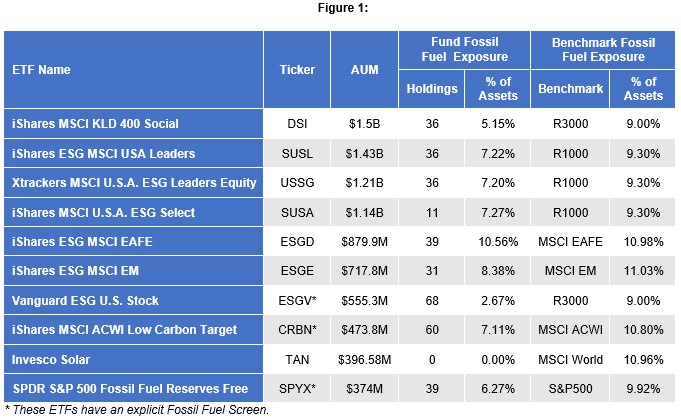
It is important to understand why this occurs within investment vehicles focused on targeting companies with positive ESG characteristics, including avoiding those with high carbon footprints. Below is a list of some common ESG investment approaches and/or strategies, and the reasoning behind why fossil fuel exposure may be higher than expected:
1. Excluding Fossil Fuel Reserves: Only excluding companies with carbon reserves from the investment universe permits ownership in both midstream and downstream fossil fuel companies, as well as Utilities that generate electricity from coal and other fossil fuels. Although these firms don’t own carbon reserves, they use them or generate large portions of their revenue from the industry. This is why SPYX has “fossil fuel free” in the name, but owns fossil fuel investments. Included in this example is the Carbon Underground 200 as an exclusion list, since excluding the Carbon Underground 200 only restricts the top 200 owners of coal and oil/gas reserves.
2. Energy Sector/Industry Exclusions: An exclusion of the full Energy sector still allows investments in other companies burning fossil fuels, such as Utilities. Additionally, the exclusion can be too restrictive, as it will also capture renewable energy companies within the Energy sector. In our experience, investors interested in climate change screens are also interested in favoring renewables. Industry exclusions also do not catch all the companies that investors would expect. ESGV, for example, has the mandate to exclude all fossil fuel companies by using reserve data and industry codes, but does not exclude services industries that do exploration, drill the wells, build/service the rigs or refine the fossil foils. Consequently, ESGV still owns some fossil fuel companies.
3. Exclusions with a Tracking Error Target: Portfolios designed to reduce fossil fuel exposure as much as possible while still tracking a benchmark index, within a defined tracking error budget, will include many fossil fuel companies if the tracking error target is low. CRBN is a prime example, as they reduce the portfolio’s carbon footprint, but still own several high carbon names.
4. Revenue & Product Involvement-based Exclusions: This approach uses company revenue linked to products (such as coal, oil and gas, oil sands, shale and nuclear power) as a determinant for exclusion. This requires making decisions on revenue cut-offs, whether to exclude only production and extraction companies or also supporting businesses, how to treat companies using fossil fuels to generate power (e.g. Utilities), and how to treat firms with indirect involvement through ownership stakes.
5. Best in Class: Some Best in Class approaches are not focused on reducing carbon or fossil fuel exposure, but rather aim to match the sector weights of the broader benchmark while investing in the companies with the highest ESG ranking. Greenhouse gas emission and carbon intensity are in the environmental pillar of many ESG scores, but may be a small weight when hundreds of factors are used. This approach can lead to Energy companies like Exxon, Chevron, or Shell in the top holdings, which for some investors is permissible due to these initiatives, while others prefer complete divestment.
All five of these are perfectly acceptable approaches to screening fossil fuel, but the screening process needs to match the investors’ expectation, otherwise it falls short. ESG investors expecting large reductions to, or elimination of, their fossil fuel exposure may be surprised to see these holdings.
These screening challenges are not confined to fossil fuels, though. Managers must make decisions for break points when applying each screen and it is not uncommon for those decisions to not match the investor’s objective. For example, most investors requesting an exclusion around Civilian Firearms agree to exclude manufacturers like Smith & Wesson (AOBC) and Sturm, Ruger & Co. (RGR). However, others want a zero-tolerance approach that also excludes retailers selling firearms, which would remove names like Dicks Sporting Goods from consideration.
There is a similar story in the case of Tobacco. Beyond excluding manufacturers, it becomes tricky to define. Rules vary on how to handle retailers selling tobacco, and some tobacco lists even exclude Disney and other movie studios.7 In addition to the current differences in tobacco screens, reaching a consensus on definitions will become more nuanced with the growth of tobacco free smoking products like e-cigarettes.
Beyond product involvement related screens like fossil fuel and tobacco some ESG investors may wish to exclude companies marred by ESG related controversies. The Volkswagen’s emissions scandal, or Wells Fargo fake accounts being perfect examples. Funds with holdings involved in severe ESG controversies is another common surprise for ESG investors. A notable current example is Brazilian mining company Vale, which had multiple damns collapse resulting in the deaths of hundreds of people. Vale is also on the list of the Carbon Underground 200 as an owner of coal reserves. Despite the extreme controversy and coal reserves, the Carbon Target ETF is just one of the ESG funds that currently has Vale among their portfolio holdings. Equifax is another recent example. Both Sustainalytics and MSCI had it poorly ranked and flagged as a high ESG controversy, but remained a holding in several large ESG funds.8 If investors feel that holdings tied to controversies like these do not align with their ESG goals, customization is a better solution.
A final example of the variability within ESG screens comes from one of the earliest adopters of Socially Responsible Investment (SRI) screening, the Catholic Church. The United States Conference of Catholic Bishops (USCCB) has formally defined Socially Responsible Investment Guidelines that most Catholic portfolios abide by.9 Interestingly, even with this very detailed document aiming to provide clear and comprehensive policies for guiding investment decisions, there is still ample ground left open to interpretation, and not agreed upon in Catholic portfolios. For example, an alcohol exclusion used by some Catholic portfolios.10 Not every Catholic institution agrees with that exclusion, which makes sense, given that the word “alcohol” is not even mentioned in the USCCB guidelines. As a $2 Billion money manager screening based on USCCB guidelines (that does not include alcohol) put it, “Jesus’ first miracle was turning water into wine”.11
This is a humorous, but perfect example of the fact that there are no universal definitions for applying responsible investing. Even within organizations boasting very detailed guidelines, there are differing opinions on how to implement ESG screens. The solution is a flexible investment process that can adjust for these differences.
Tilting Away from ESG Values
Screens, however, are not the only available tools for incorporating ESG goals into a portfolio. Investors may also rank companies by ESG metrics or scores to determine which names are over or underweighted within a portfolio with ESG Tilts.
While scoring companies implies more objectivity in the investment selection process, the various methodologies that a company can be rated on introduces potential issues. With the arrival of complex third-party scoring systems, including some that aggregate more than 300 different factors into a single composite score, there are numerous ways that an investor’s individual ESG goals can be overlooked.
ESG tilts are initially developed by determining which data and/or data provider(s) will be used and how the selected data will be weighted for calculating an ESG score. With estimates of nearly 600 different ESG data products available from some 150 organizations,12 investors have no shortage of options, sparking debates over which solution(s) to select. While the growth in quantity and quality of ESG data has generally been applauded, a common critique has centered around the low correlation of ESG scores published by different data providers. Some critics have gone so far as concluding that this low correlation reduces the viability of ESG data in the investment process. While such claims deserve attention, we view the variations in ESG data providers much more favorably than the consensus. Instead of relying on composite ESG ratings, we believe that dissecting each provider’s methodology and underlying data points can lead to custom scoring that better captures the ESG measures an investor cares about most.
To further understand how ESG tilts can misrepresent investor values, we must first recognize the subtle differences in how providers define and measure the various aspects of ESG. One provider may focus on ESG risk, another on ESG values and impact, while a third focuses on ESG sentiment or ESG controversies.
Consider the methodology and scoring of the two leading ESG data providers, MSCI and Sustainalytics, who have each developed different definitions and measurements of what constitutes a company’s ESG rating.13 14 15 MSCI emphasizes an issuer’s exposure to ESG-related risks whereas Sustainalytics prioritizes a company’s ESG impact, transparency, and values.
This translates to numerous indicators and their corresponding weights, to comprise a composite ESG score. Depending on how an investor wishes to define and capture ESG exposure, data from either provider can be used however, unpacking and controlling for the factors that a client cares about most must be done with great care. Otherwise, indicators will be included that a client does not believe accurately captures their definition of ESG. The consequence is a watering down of the ESG factors that they do wish to prioritize.
To illustrate how alternative methodologies translate to ratings, we examine the insurance industry. Each data provider defines, measures, and weights various indicators, according to a materiality map representing the formula used to roll indicators into an overall ESG score.16 MSCI rates insurance companies according to one factor, exposure to climate change risk, while Sustainalytics uses between 15-20 different factors, with some of the heaviest weights attributed to environmental-related controversies, responsible asset management, renewable energy use, and sustainable financial initiatives. Accordingly, Prudential Financial Inc., a company with some business operations tied to climate change risk17 and sizeable investments in renewable energy projects and green buildings, ranks much more favorably with Sustainalytics than MSCI.18 Therefore, an investor more concerned with climate change risk may find MSCI ESG data more compelling, whereas an investor that perceives an opportunity related to the transition to renewable energy sources and green technology will be better suited using Sustainalytics. If investors and asset managers are willing to truly understand the granular differences within the data, they will greatly improve their ability to solve for a wider range of ESG goals.
To highlight the importance of the weighting schemes after a data provider is selected, Figure 2 compares two ESG composites: one standard “off the shelf” approach from a leading data provider and one fully customized and designed to focus on specific social and environmental factors. The “off the shelf” option is Sustainalytics, and then the OSAM custom ESG score rolls up a subset of the underlying Sustainalytics data but strictly focuses on factors that a client specified and weights the ones the client finds material more heavily. The custom OSAM ESG score also removes any data items that the client did not wish to be included.19
For both scoring systems, a global universe is used, with a value of 0 indicating the highest ranking ESG percentile, and 100 being the lowest ranking. To simplify the analysis, we will categorize companies with a score under 50 as “Good ESG” and those over 50 as “Bad ESG”. As such, the portfolio should be designed to prioritize Good ESG companies and underweight Bad ESG companies.
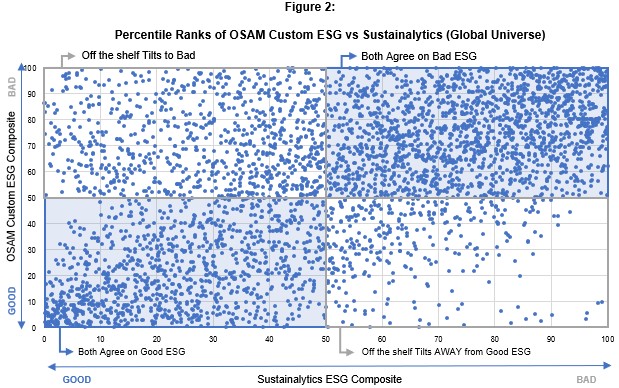
To emphasize using a custom ESG score can better capture an investor’s values, it is important to view each quadrant from the perspective of the impact and/or unintended consequences this can have on a portfolio. The bottom left and top right quadrants, highlighted in blue, represent cases where companies’ Sustainalytics score and OSAM ESG score are in alignment. If an investor were to utilize either scoring mechanism, the resulting portfolio should overweight companies in the bottom left quadrant and underweight or avoid those in the top right. Unfortunately, this does not hold true for the remaining two sections, highlighted in gray. The upper left portion represents cases where companies rank favorably according to Sustainalytics methodology but are viewed as Bad ESG companies by the client, while the bottom right represents the opposite scenario.20 If an investor relied solely on the composite Sustainalytics score to construct a portfolio, they may overlook the investment opportunities available in the bottom right section while diluting their own ESG preferences by including those in the top left, which tilt away from the ESG values the investor cares most strongly about.
Factors Improve ESG Return Expectations
Separate from the numerous methods for constructing an ESG portfolio is the question of whether ESG investing is linked to returns. At OSAM, we believe that regardless of how an investor wishes to gain ESG exposure, there are known alpha factors that can contribute positively to a portfolio’s performance, and should have a role in the investment process. Our research indicates that controlling for Value, Momentum, Earnings Quality, Earnings Growth and Financial Strength (alpha factors) can improve returns within ESG strategies. Furthermore, utilizing these themes to remove poor quality and expensive names has more efficacy in ESG investing than other, more traditional strategies.
To test the merits of factor investing within ESG portfolios, we developed a research universe called “ESG All Stocks”, which is comprised of every global company flagged as having positive ESG practices (Good ESG). To identify these companies, we compiled the unique holdings from the oldest funds with a distinct ESG or thematic sustainability mandate, as well as companies referenced in the earliest responsible investing or sustainability research reports.21 The ESG All Stocks universe extends our ability to study the effect of factors on Good ESG companies to the mid-1980s, which includes multiple market cycles. This addresses a known difficulty associated with extrapolating results from ESG investing, given that company-level ESG data has only been available for a decade.
Our first insight draws from claims that investing in companies with positive ESG practices can mitigate risk. While ESG factors can be indicative of how a company perceives or handles risks tied to environmental, social, or governance factors, we believe that going an additional step and evaluating a Good ESG company’s factor profile can help further avoid investments with weaker return profiles.
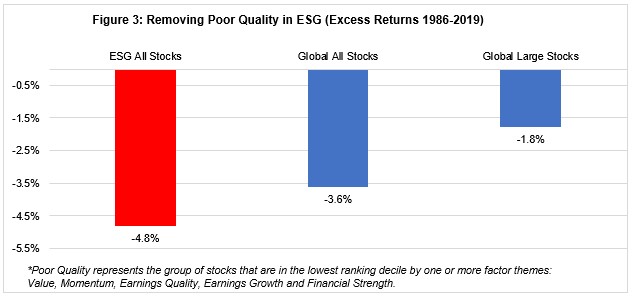
Figure 3 illustrates the effect that companies with the lowest ranking factor profile (Poor Quality) can have on performance.22 The most pronounced results come from the ESG All Stocks universe with underperformance of 4.8% annualized. We advocate for active stock elimination in all investments, which is the practice of identifying and avoiding companies that are likely to underperform. In the case of ESG, poor quality names may exhibit best in class ESG practices, but not good investments. Active elimination of poor-quality companies has historically been more effective at improving returns within ESG portfolios than in non-ESG strategies.
An investigation of the underlying factors paints a similar story. Figure 4 highlights the highest and lowest ranking quintile of companies in the ESG universe within each factor theme and the excess returns generated between 1986-2019.23 Across each factor, ESG companies within the top quintile have shown the potential for excess return whereas those in the bottom quintile have suffered.
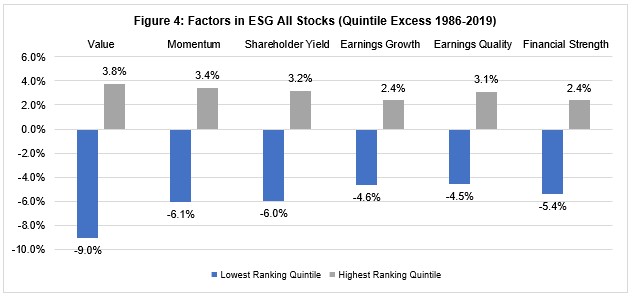
Put simply, factors within ESG have historically improved investment decisions by separating good and bad investments. We believe this is an important point that often fails to receive adequate attention, as the primary focus within ESG investing has been identifying companies with positive ESG practices, and debating which industry-specific aspects are material ESG considerations. Regardless of your definition of ESG, supplementing your view with a focus on companies exhibiting better factor profiles can lead to improved risk-adjusted returns. To highlight this point further, in Figure 5 we examine the return profile of ESG All Stocks, Good Quality ESG All Stocks and Cheapest Quintile ESG stocks against the broader benchmark.24
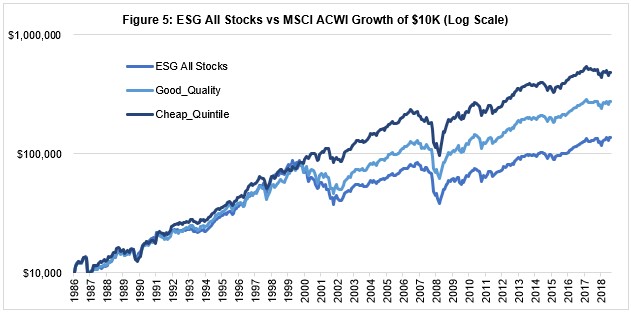
While the entire ESG investment universe has shown to track the MSCI ACWI relatively closely, for the subset of ESG companies with the highest-ranking factor profile and good ESG, the result is more pronounced. ESG investors should make certain that their portfolios also favor factors like quality and value.
To highlight that many of the more popular ESG funds are not considering these factors, we can show their bias towards more expensive names. Figure 6 plots the range of valuations of these portfolios (gray bar) with the valuation of the underlying broader index. In most cases, the broader benchmark is at the very bottom of the range. Some of the more thematic funds with larger biases to expensive sectors like technology drive the upper end of the range.
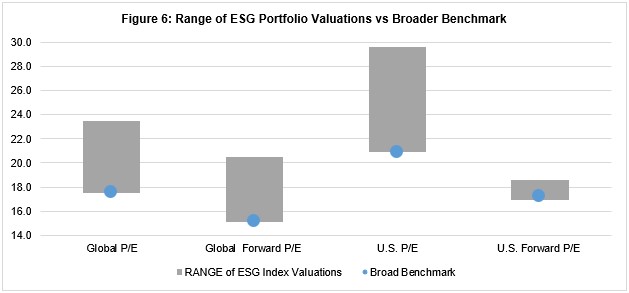
As investors and managers contemplate the potential for excess returns within ESG, they should be aware that some highly rated ESG companies are also bad investments. Historically, alpha factors have been effective at separating Good ESG and Good Investments from Good ESG and Bad Investments. Some of the more popular ESG portfolios have not controlled for this, but it is a bias that is easily adjusted in custom portfolios that can target the factor exposures investors want.
OSAM Tailored ESG Platform
At OSAM, we have designed our portfolio management platform to customize granular decisions in all areas of the ESG framework. We can implement any measurable custom screen, tilt or factor exposure to deliver strategies that can better align a client’s unique ESG goals than any off the shelf product. We have managed custom Separately Managed accounts (SMAs) since launching the company, and have continually enhanced that process to offer increasingly customized ESG and tax managed accounts.
Our customization process is akin to collaborating with an architect on a set of design plans. We work with clients to identify the values they want represented, and design an initial portfolio that we feel best captures those goals. Lastly, through a series of follow-up conversations we adjust a range of portfolio characteristics, as necessary, to ensure the result represents the client’s vision.
We have included several case studies to highlight our capabilities within the ESG investing landscape.
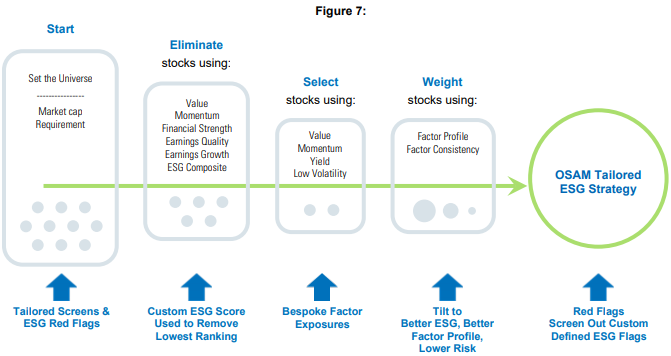
Case Study #1 – Global Environmental Impact
Request: Build a thematic environmental strategy tied to five themes:

There were four main challenges solved through customization:
1. Favor Green Revenue Companies25: Top holdings should be comprised of companies that directly contribute to positive environmental change. Standard ESG products using a “Best in Class” approach tend to underweight these companies, with few to none of them in the Top-10;
2. Maintain Diversification: Avoid large sector imbalances so that this product can serve as a core equity allocation with tracking error managed relative to the MSCI ACWI. Some thematic ESG products have no exposure to Financials, Healthcare, and Communications. These sectors are 40% of the ACWI Index and a passive investment to these green revenue names has a tracking error approaching 6%.26
3. Reduce Fossil Fuel Exposure: Minimize exposure to fossil fuel companies without applying blanket exclusions such as removing the entire GICS Energy sector;
4. Achieve Excess Returns: Outperform the global equity market with factor themes such as Value, Momentum, and Quality while maintaining ESG exposure.
To overcome these challenges, we developed a custom investment universe incorporating the requested exclusions and tilts. While green revenue companies were automatically included, to overcome diversification issues, we developed a custom environmental ESG composite score to identify highly ranked companies, by industry, that better aligned with the stated impact themes.
Additionally, to reduce the portfolio’s exposure to fossil fuels, we developed a customized exclusion list that did not remove renewable energy companies from consideration like a complete sector exclusion would. Once a diversified investable universe was developed, we utilized our factor-driven investment process to identify and select companies that not only met the desired ESG criteria but were also sound investments based on their characteristic profile.
Designing a portfolio with specific ESG goals and return expectations does not need to come at the expense of large sector imbalances or investing in expensive companies, both of which can greatly increase your investment risk and sacrifice returns. The resulting portfolio that OSAM constructed met diversification goals, had a lower tracking error than most thematic ESG products, and favored alpha factors relative to the MSCI ACWI, characteristics that have historically been tied to good excess return potential.
Case Study #2 – Tailored Social Solution (Obesity and Diversity)
Request: Develop a global portfolio representing the client’s social values specific to diversity and physical wellbeing. For diversity, the focus was on the number of women represented on board and executive roles and inclusive practices in the workplace, including LGBTQ rights. The wellness goals were centered around avoiding companies that profit from products linked to the obesity epidemic. The client’s occupation involved seeing the day-to-day impacts of obesity, prompting a preference to avoid investing in the companies they deemed most responsible. The client was using very broad exclusions to capture these ESG goals, and was aware that customization allowed for more precision in the investment selection process.
There were five main challenges were solved through customization:
1. Soft Drink & Restaurant Divestment: The client believed that companies providing poor quality food in school cafeterias, fast food restaurants, and soft drink producers were most linked to the insurgence of obesity. However, they were excluding the entire restaurant and beverage industries. While this exclusion avoided companies that the client found objectionable, it also applied to many other companies in the industry that were not directly tied to the obesity epidemic, including those that offered healthy alternatives;
2. Favor Gender Diversity: Investing in companies with gender diversity was a key priority for the client however, this had not yet been implemented because the available options were overly restrictive, and for a global portfolio, resulted in large regional imbalances. For example, excluding all companies without a female board member removed a large percentage of Japanese companies, and very few U.S. companies, comparatively;
3. Focus on LGBTQ Rights: The client had an exclusion in place to avoid exposure to any country with a history of LGBTQ criminalization. This was too blunt a restriction as it also removes companies that are supportive of LGBTQ rights within those countries;
4. Avoid ESG Controversies / Headline Risk: ESG ETFs and mutual funds often had companies with ESG related controversies in their top holdings. As an investor in these products, the client felt that this did not align with what their ESG portfolio was trying to accomplish;
5. ESG through Value Investing: The client believed in value investing and wanted their ESG goals represented in a portfolio that also had large discounts relative to its benchmark. This combination of ESG with Value currently did not exist in the market.
Most of the work in this tailored ESG portfolio was focused on developing custom investment universe exclusions. In many cases, this entailed designing more precise exclusions instead of broadly removing entire industries, potentially excluding companies that shared the values of the client. For the soft drink and restaurant screen, we compiled data from various research studies and healthy restaurant lists, and utilized third-party consultants to build a more precise obesity restriction. For the LGBTQ screen, we partnered with activist groups in countries such as Singapore (which has a history of LGBTQ criminalization) to identify local, supportive companies with policies against this view. To avoid controversies, we built a red flag process into the portfolio that liquidates and excludes companies with severe ESG controversies.
In addition to custom screens, we also designed a unique ESG composite score, which included gender diversity and other ESG goals, to tilt towards companies most aligned with their values and away from those that were not. This was incorporated in a way to let values drive the investment process, as it focused on companies that met their ESG goals and had characteristics of a good investment, relative to peers. The final portfolio was a much more precise representation of both the values and factor advantages the client wanted represented.
Case Study 3: Green Beta: Improve Passive Allocations with an ESG Lens
Our third case study details our capability to improve passive allocations with an ESG lens. Passive allocations can be improved with custom portfolio construction to meet ESG goals and active ownership in the form of matching proxy votes to client values. These approaches have taken on names such as “Green Beta” or “Impact Beta” given their aim to deliver a defined ESG purpose while achieving market- like returns. In most situations these portfolios can be managed with minimal effect on risk and return profiles satisfying fiduciary duty objectives.
Rather than focusing on maximizing the alpha potential of a client’s ESG portfolio, with a passive allocation, we aim to minimize tracking error, which can take two forms:
1. Minimize Tracking Error Given a Set of ESG Goals;
2. Set a Tracking Error Target & Maximize ESG Goals.
Minimize Tracking Error: These portfolios can include any socially responsible or values-based screen (e.g., divesting from private prisons, tobacco or fossil fuels and minimize tracking error). Passive portfolios with religious restrictions also fit here. Any custom screen or tilt can be applied if it does not overly constrain the investment universe so that beta can still be an option. This approach can also appeal to investors trying to reduce sector or company exposures that correlate to other portions of their portfolio, like a Google employee that wants to exclude Google due to exposure elsewhere.
Tracking Error Target: The most common example are portfolios that reduce stranded asset/carbon footprint risk as much as possible within a defined tracking error budget (“Green Beta”). This approach has been referred to as “a free option”27 because it removes risk(s) that the investor perceives as mispriced in the market and does so without a material effect on the risk and return profile of the allocation. This can be accomplished with other risks or values-based screens the investor wishes to control within a tracking error budget (e.g., income inequality, data privacy, etc.)
Custom Proxy Voting: Traditionally, passive market exposure has come with passive ownership and voting of shares. A notable gripe amongst responsible investors is that passive shares are rarely voted in support of ESG initiatives: the largest index funds consistently rank amongst the lowest in the industry on voting for ESG-oriented proposals.28 Our approach to ESG beta solves for this operational oversight. Subject to asset minimums, we can incorporate custom, client-directed voting guidelines to infuse a level of active ownership within an otherwise passive portfolio. Investors can now make an impact as active owners while remaining passive in their investments. In many cases we can provide these portfolios to our clients free of charge, and tax manage them to provide tax alpha as well. Contact us to learn more at esg@osam.com.
Conclusion
Some of the more popular ESG products are designed to be one size fits all. This approach often waters down and tilts away from the values investors want and care about, including performance factors like Value, Momentum and Quality. The better solution is reached by tailoring a portfolio to accomplish the unique goals of the investor. Without some level of customization investors may realize their ESG portfolio is not investing as close to their values as they thought.
If you have an ESG challenge or value that you are having difficulty representing in your portfolio, please reach out to us at esg@osam.com.
Appendix
ESG All Stocks Universe Compilation: Holdings data from PAX Balanced Fund, The Dreyfus Opportunity Fund, MSCI ESG Select & Leaders Indices, The Domini/MSCI KLD 400 index, Calvert Balanced Fund, and thematic funds such as the Fidelity Select Environment and Alternative Energy Portfolio. We also reviewed some of the earliest known examples of ESG research like that of Milton Moskowitz which focused on corporate social responsibility. The unique company list from all these sources make up the ESG All Stocks Universe.
1 https://www.wsj.com/articles/why-its-so-hard-to-be-an-ethical-investor-1535799601
2 There are many terms/acronyms that are part of the ESG terminology. In this paper we use “ESG” as an umbrella term to include SRI, ESG, Thematic, Impact, Religious values etc. Although SRI can be used to define only values-based exclusions, negative screening is a valuable tool across many responsible investing approaches, so we prefer the term “ESG Screens” of which SRI is a subset.
3 http://www.gsi-alliance.org/wp-content/uploads/2019/06/GSIR_Review2018F.pdf
4 http://www.gsi-alliance.org/wp-content/uploads/2019/06/GSIR_Review2018F.pdf
5 Holdings analysis of each ETF sourced from Fossil Free Funds, https://fossilfreefunds.org
6 The distinction is they aim to only excluded companies with carbon reserves allowing them to own fossil fuel companies and utilities that burn them as long as they don’t own carbon reserves.
7 https://tobaccofreefunds.org/faq
9 http://www.usccb.org/about/financial-reporting/socially-responsible-investment-guidelines.cfm
11 https://www.forbes.com/sites/jeffkauflin/2017/12/06/portfolio-placebos/#3be9ece4c045
13 “A Survey of ESG Vendor Data: Strategies for Managing Score Differences” By Anthony A. Renshaw, Ph.D.
14 “Why It’s So Hard to Be an ‘Ethical’ Investor” By Jon Sindreu and Sarah Kent.
15 “The ESG Data Challenge” by Rakhi Kumar and Ali Weiner.
16 Materiality Map is another ESG term common now in the industry. Essentially materiality boils down to two questions 1) which ESG factors will be used in which industries? And 2) how will those factors be weighted to calculate a rolled up composite ESG score. Materiality calculations vary drastically from Sustainalytics to MSCI to SASB to other providers. Investors need to understand these differences in order to know what definition of ESG is used in their portfolio. Or even better come up with your own weighting system to overweight your unique values and underweight the factors that neither matter to you nor matter when it comes to portfolio returns.
18 Note that Sustainalytics as of 2019 has an ESG risk-based dataset offered alongside their legacy ESG flagship data product.
19 For those familiar with a Materiality Map, this is a completely custom materiality map to weight factors based on the clients views of what is most material to them. This is the custom composite that we built for the client in case study #2.
20 The most dominant theme in the group of names that did well according to the custom score yet ranked poorly by Sustainalytics are green revenue companies. Green revenue companies are those that derive 50% or more of their revenue from environmental impact themes.
21 Please see Appendix for further details on how we created the ESG All Stock investment universe.
22 Poor Quality represents the group of stocks that are in the lowest ranking decile by one or more factor themes: Value, Momentum, Earnings Quality, Earnings Growth and Financial Strength.
23 Excess returns with the ESG All Stocks universe as a benchmark.
24 MSCI ACWI was included to put the return statistics in context relative to a global benchmark. But we feel conclusions should not be drawn of ESG All Stocks vs the ACWI because of market cap and regional biases during periods of the test.
25 Green revenue companies sell products and services that can directly be tied to positive environmental impact goals. They must have 50% or more of their revenue tied to an environmental impact theme.
26 The MSCI Global Environmental index is comprised of all global green revenue companies.
27 Andersson, Bolton & Samama (2016) Hedging Climate Risk, Financial Analysts Journal.




